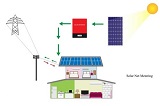The clean energy industry has earned renown for its adaptability and willingness to develop new solutions to keep up with customer demand. Researchers are always seeking ways to make renewable energy more efficient and affordable, and perovskites have all the necessary ingredients to revolutionize solar panel technology.
What Are Perovskites?
Perovskites are crystal compounds with wide-ranging applications. Many chemical elements can combine to form perovskite structures. Scientists have taken advantage of this adaptability to develop perovskite crystals with various physical, optical and electrical characteristics. Today, some of the most common applications for perovskite crystals include ultrasound machines, memory chips and, more recently, solar cells.
 Source: Saule Technologies
Source: Saule Technologies
Since the mid-20th century, silicon has been the primary semiconductor material used in solar cells. That’s because this element’s properties align well with the UV spectrum and it is relatively plentiful and stable. However, producing the large silicon crystals necessary to manufacture traditional solar panels requires a multi-stage process that tends to be relatively expensive and energy-inefficient.
In their search for alternative solar cell materials, scientists have turned to versatile perovskites to develop semiconductors with properties that mimic silicon. Manufacturers can now make perovskite solar cells using straightforward techniques like 3D printing for a fraction of the cost and energy.
Examining Perovskites’ Potential
In recent years, perovskite solar cells have shown remarkable progress with increased conversion efficiency. In early 2020, one research team achieved a breakthrough by developing a perovskite-silicon hybrid with a predicted efficiency of nearly 40%.
While these hybrid solar cells have become exponentially more productive in a very short period, some notable challenges remain before perovskite photovoltaic cells can achieve peak competitiveness as a commercial technology. Toxicity from lead leakage is one of these obstacles, and sturdiness is another. Compared to other available technologies, perovskite solar cells have somewhat limited stability. To improve this durability in harsh weather conditions like rain, snow and heat, researchers are studying the degradation in perovskite materials and contact layers. They’re also exploring alternative compositions to mitigate lead toxicity. The resulting new designs should make future perovskite solar cells a practical solution for a range of circumstances.
Clean Energy Applications for Perovskites
Despite the hurdles, many promising uses for perovskite solar cells are gradually emerging on the market, including portable devices like cellphones and cameras. Some of the companies, like Saule Technologies in Warsaw, Poland, have innovated a new inkjet-printing technique for creating perovskite solar cells and started integrating them into their revolutionary product, Solar Carport.











